Making Yogurt
How to Make Yogurt By Machine: 1. Steps (with Pictures)1. Lumpia Recipe here. Find out how much milk you need from the instructions with the machine. Use whole, 2%, 1% or skim milk and add 1/4 cup powdered, dry milk for each quart. Heat that amount of milk your yogurt maker will hold in a crock pot on low overnight. You can do the same thing on your stove in a double- boiler.
Know Your Yogurt. We believe in naturality, sustainability, and transparency. Learn how we’re pledging all three in the making of our yogurt. So you can never use raw milk yogurt then. If you’re always making with only raw milk, you always need a starter culture? I buy raw milk yogurt all the time and. Yogurt, yoghurt, or yoghourt (/ ˈ j oʊ ɡ ər t / or / ˈ j ɒ ɡ ə t /; from Turkish: yoğurt; other spellings listed below) is a food produced by bacterial. If you want to save a huge amount of money at the grocery store, try making your own yogurt. Homemade yogurt is much less expensive than yogurts purchased from the. Store-bought yogurt may be convenient but it can't compare to the mild creaminess of homemade. The good news is that making yogurt is incredibly easy as long as you.
· One caveat about making your own yogurt or eating store bought yogurt and thinking you’re getting the possible benefits of all the probiotics like. Substitute plain yogurt for sour cream for less calories. Get more tips and substitutions for cooking with yogurt. Try our easy homemade yogurt recipes and learn how to make yogurt at home. Making homemade yogurt is not only delicious but it's also healthy.
Bring it to the froth stage or between 1. F. Keep it at this temperature for at least 1. Optionally, for every gallon of milk you can add a cup of sugar and a pinch of salt.
With 250+ products for cheese making or yogurt making we are a great place to buy cheese making supplies and Ingredients online We offer a wide selection of cheese.
This helps the bacteria work and improves the taste of the resulting yogurt without decreasing it's nutritional value. Cool the milk to just under 1. F. You'll need a thermometer to do this as temperatures are important. This milk now is referred to as tempered milk. Blend part of the tempered milk and 2 tablespoon (2.
This is the starter. The culture can be store- bought yogurt with live cultures in it, packets of yogurt culture bought online or at your local health food store, or from prior yogurt you have made and kept refrigerated or frozen. This step is extremely important as the culture has the bacteria in it that you needs to be distributed throughout the yogurt. You can use flavored yogurt.
The final yogurt may taste faintly of the flavor you use. Keep the amount of any store- bought yogurt culture you use to under 5 tablespoons (7. Yogurt has acid in it which can curdle milk. Pour the starter into the rest of the tempered milk and stir for at least 1. Pour the milk into clean jars or containers and put them in your yogurt maker. Follow the instructions from your yogurt maker to start it going.
To find out if your yogurt is ready, after 2 hours, slightly jiggle one of the jars to see if it is firm. If it is, it is ready. You may want to let it go longer, up to 1.
When you are ready, take the jars out and put them in the refrigerator to cool and set further. At this point you can add flavorings, fruit and other items like granola. Save part of the yogurt for the next batch. After 5 or so batches, you may want to start fresh to ensure the cultures don't degrade.
